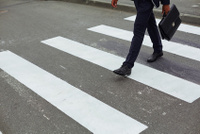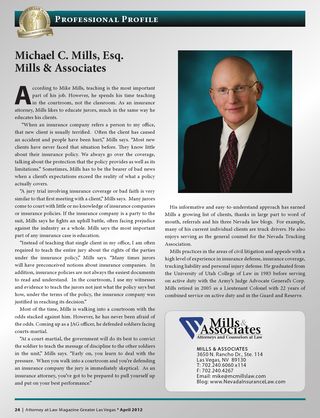 Pedestrian Anderson was walking across the street when driver Baltrusaitis accidentally hit him with his car. Anderson and Baltrusaitis were the only witnesses to the accident. Pedestrian Anderson’s injuries were so serious that he was unable to communicate about the accident.
Pedestrian Anderson was walking across the street when driver Baltrusaitis accidentally hit him with his car. Anderson and Baltrusaitis were the only witnesses to the accident. Pedestrian Anderson’s injuries were so serious that he was unable to communicate about the accident.
Perhaps that is why there was no evidence to contradict the evidence favorable to the driver. The Traffic Accident Report, the deposition testimony of driver Baltrusaitis and his accident reconstruction expert’s opinion all placed pedestrian Anderson five to ten feet outside an unmarked crosswalk when he was hit.
In light of the favorable evidence, Mr. Baltrusaitis filed a Motion for Summary Judgment. In his motion, he acknowledged the crosswalks could be marked or unmarked. In Nevada, crosswalks are currently defined as follows:
NRS 484A.065 “Crosswalk” defined. “Crosswalk” means:
- That part of a highway at an intersection included within the connections of the lateral lines of the sidewalks on opposite sides of the highway measured from the curbs or, in the absence of curbs, from the edges of the traveled portions of highways; or
- Any portion of a highway at an intersection or elsewhere distinctly indicated for pedestrian crossing by lines or other markings on the surface.
As a pedestrian walking outside of a crosswalk, Mr. Anderson had a duty to yield to the driver. The current statute reads:
NRS 484B.287 When pedestrian must yield right-of-way to vehicle; when crossing at crosswalk is required; . . . :
- Every pedestrian crossing a highway at any point other than within a marked crosswalk or within an unmarked crosswalk at an intersection shall yield the right-of-way to all vehicles upon the highway.
In addition to the statutes, driver Baltrusaitis pointed to two earlier cases, Johnson v. Brown, 77 Nev. 61, 359 P.2d 80 (1961), and Fennell v. Miller, 94 Nev. 528, 583 P.2d 455 (1978), both of which were favorable to the driver and against the pedestrian in similar circumstances. Based on the above, the trial court granted driver Baltrusaitis’ Motion for Summary Judgment.
However, in Anderson v. Baltrusaitis, 113 Nev. 963, 944 P.2d 797 (1997), the Nevada Supreme Court reversed.
The Court acknowledged the prior opinions but pointed out that those cases had been decided before Nevada adopted it Comparative Fault statute, NRS 41.141. The Court said that under the statute, the comparative fault of a plaintiff does not bar recovery if plaintiff’s negligence is not greater than the negligence of the defendant.
The Supreme Court also said that the violation of a statute creates negligence per se only if the injured party belongs to the class of person that the statue was intended to protect. Ashwood v. Clark County, 113 Nev. 80, 86, 930 P.2d 740, 744 (1997). The Court said that the crosswalk statute was created to protect pedestrians and not drivers and therefore driver Baltrusaitis could not establish pedestrian Anderson’s negligence per se by pointing to his violation of the statute.
The court went on to say that the driver Baltrusaitis may have had a statutory duty of his own, namely to decrease speed when approaching an intersection. The current statute provides:
NRS 484B.603 Duty of driver to decrease speed under certain circumstances;
- The fact that the speed of a vehicle is lower than the prescribed limits does not relieve a driver from the duty to decrease speed when approaching and crossing an intersection, . . . or when special hazards exist or may exist with respect to pedestrians or other traffic. . .
The unmarked crosswalk was created where two roads intersected adjacent to a casino, the lights of which may have made pedestrians particularly conspicuous. The court went on to say that determining whether driver Baltrusaitis or pedestrian Anderson where negligent and if so in what shares was an issue for the jury, not the court. The Supreme Court reiterated its reluctance to affirm summary judgments in negligence cases and restated its policy of allowing such cases to be tried on their merits.
Pedestrians should exercise caution when crossing the street and should use crosswalks where available. But even if they don’t, they still might recover from a negligent driver. And count on every one of these cases to go to a jury. If you need further information on this important topic, please don’t hesitate to contact Michael C. Mills of Bauman, Loewe, Witt & Maxwell at 702-240-6060 x 114 or contact him by email at mmills@blwmlawfirm.com.
 Follow
Follow Email
Email


